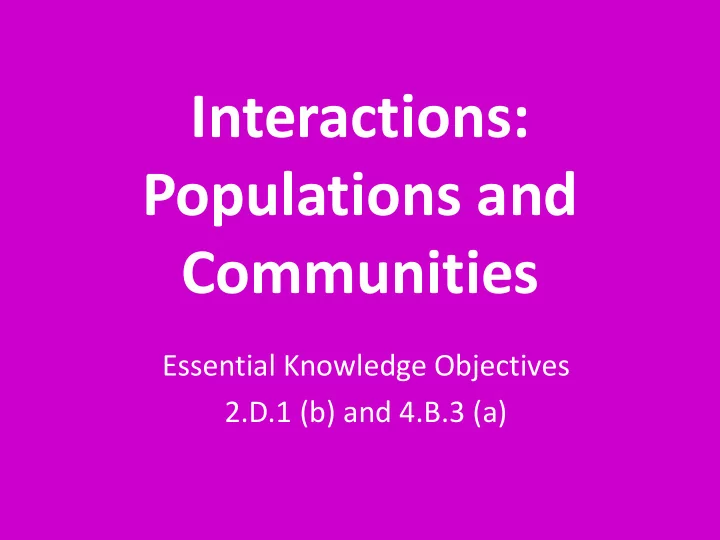

Interactions: Populations and Communities Essential Knowledge Objectives 2.D.1 (b) and 4.B.3 (a)
Population Interactions • A population of organisms has properties that are different from those individuals that make up the population • Cooperation and competition between individuals contribute to these properties
Population Interactions • Relationships among interacting populations can be characterized by positive and negative effects , and can be modeled mathematically
Community Interactions • Classified by whether they help, harm or have no effect on the species involved • Species interactions strongly influence the structure of communities • Community : A group of populations of different species in an area
Examples of Community Interactions • Interspecific competition (-/-) • Predation (+/-) • Herbivory (+/-) • Symbiosis - Parasitism (+/-) - Mutualism (+/+) - Commensalism (+/0)
Interspecific Competition (-/-) • Individuals of different species compete for a resource that limits their growth and survival
Competitive Exclusion • Occurs in a community when two species compete for limited resources • The local elimination of the inferior competitor is called competitive exclusion • Two species cannot coexist permanently in a community if their niches are identical
Competitive Exclusion
Resource Partitioning (a solution to the competition problem) • Resource partitioning is the differentiation of niches that enables similar species to coexist in a community • Ecological niche - the specific set of biotic and abiotic resources that an organism uses in its environment • Fundamental niche versus the realized niche
Resource Partitioning
Predation (+/-) • An interaction in which one organism captures and feeds on another organism • Predator and prey • What are some advantages of predation? (Think!)
Canadian Lynx and the Hare
Herbivory (+/-) • Interaction in which an organism eats parts of a plant or alga
Plant Defenses Against Herbivory • Chemical defenses – produce chemicals that are toxic or taste bad • Mechanical defenses – prickles, thorns, spines or trichomes • Thigmonasty – responses to touch, leaves curl up or close • Leaf shedding or warning coloration
Symbiosis – Parasitism (+/-) • A symbiotic relationship in which one organism benefits at the expense of the other organism
Symbiosis – Commensalism (+/0) • A symbiotic relationship in which one organism benefits and the other organism is neither helped nor harmed
Symbiosis – Mutualism (+/+) • A symbiotic relationship in which both organisms benefit
Community Interactions • Structure of a community is measured and described in terms of its biodiversity , which is measured in species richness (total number of different species in a community), and the relative abundance of each species present
Community Interactions
Recommend
More recommend